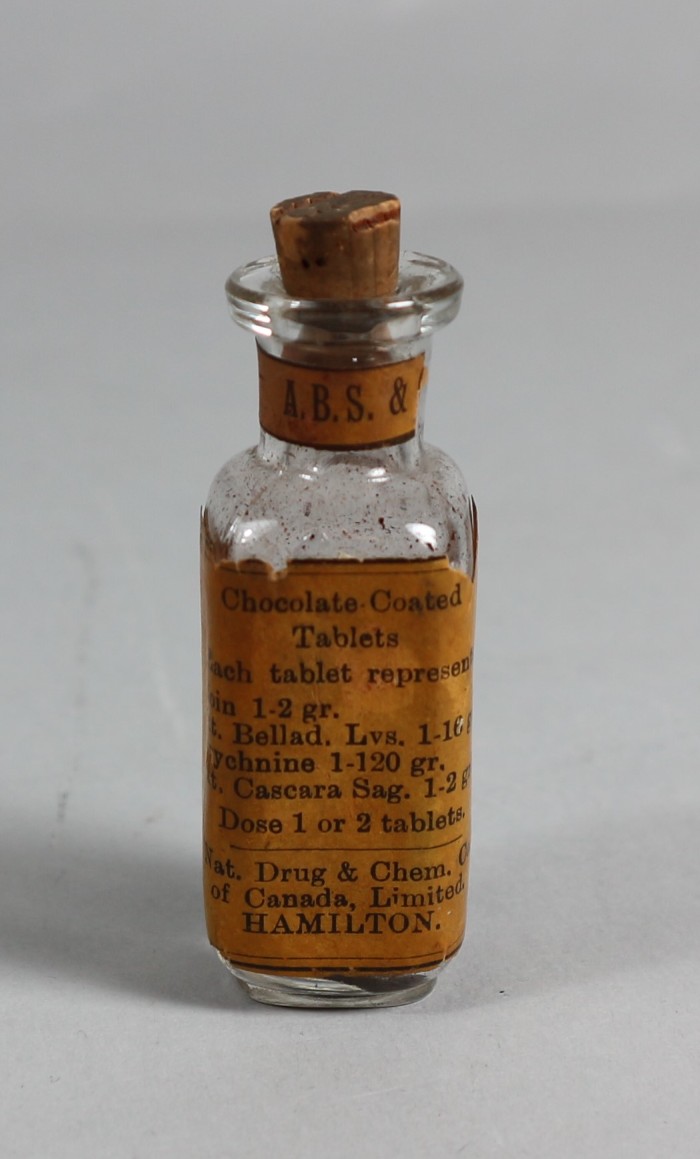Bottle, Medicine
Artifact
Identifier:
2012.001.220Description
Clear glass bottle with cork stopper and two paper labels around the neck and body of the bottle. The bottle has a rectangular base, with a short neck and wide rim around the mouth. The original contents of the bottle were chocolate-coated tablets containing a compound of aloin, strychnine, belladonna, and cascara. It was produced by the National Drug and Chemical Company of Canada. There is residue inside of the bottle.Additional Information
The National Drug and Chemical Company was incorporated in 1905, with headquarters in Montreal. Throughout 1906, the corporation initiated the integration of 19 wholesale drug companies and 13 retail stores. National Drugs merged with other various regional drug companies across Canada throughout the 20th century, and became Canada's leading drug wholesaler and manufacturer, and one of the largest pharmaceutical companies in the British empire. In 1991, the McKesson Corporation of San Francisco acquired a 100 percent interest in the company (then known as Medis Health and Pharmaceutical Services). In 2002, the McKesson Canada name was adopted and a new brand was introduced, which it is still known by today.;Compounds of aloin, strychnine, and belladonna were used as a stimulant and to treat a variety of human ailments. Most commonly, the purgative (laxative) effects of the drug were used to treat constipation and gastrointestinal malades.Aloin is derived from the aloe plant, and has been used as a stimulant-laxative used to treat constipation. Aloin has been used in traditional medicine since antiquity, and has been known to produce harsh side effects. As of 2002, the US FDA mandated that manufacturers stop making over-the-counter medications using aloe, however it is still allowed in dietary supplements and food products.
Strychnine is a highly toxic alkaloid that has most commonly been derived from the seeds of the Strychnos nux-vomica tree, native to the tropical forests of Southern India, Sri Lanka and Indonesia. Its toxic effects have been known since the times of ancient India, however in the late 19th century and early 20th century, it was used as an athletic performance enhancer and recreational stimulant. It was believed that the convulsant effects it produced were beneficial.
Belladonna (also known as deadly nightshade) is a poisonous, herbaceous plant native to Europe, North Africa, and Western Asia. It is in the same family as tomatoes, potatoes, and eggplant, however its foliage and berries are highly toxic. Belladonna extracts have been used for centuries in herbal medicine as a pain reliever, muscle relaxer, and anti-inflammatory, and to treat menstrual problems, peptic ulcer disease, histaminic reaction, and motion sickness, among other ailments. The plant has also been used in cosmetics, dietary supplements, as a recreational drug, and as a poison.
Cascara sagrada is derived from the bark of a tree found in western North America, and has long been used by Indigenous peoples of the area for its medicinal properties. It was accepted into Western medical practice in the US in 1877 for use as a laxative. It was a principal ingredient in most over-the-counter laxatives until 2002, when the US FDA banned its use along with aloe. It can have severe side effects, and is potentially a carcinogen.
Creator:
National Drug & Chemical Co. Ltd. Toronto-Montreal
(manufacturer)
(created)
